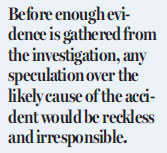Escalator accident needs thorough probe to alleviate public concerns
Updated: 2017-04-03 07:16
(HK Edition)
|
|||||||
While the escalator accident which happened in Langham Place on March 25 was indeed a rare event, shocking video footage of the accident and the serious consequences - 18 people injured - have obviously raised concerns among local residents about escalator safety. Perhaps, a better understanding of the basic configuration of an escalator and its operations will help alleviate public anxiety.
An escalator runs on a supporting structure, or a truss. At the upper landing side, there is a driving machine inside the machine room. The driving machine is comprised of a motor, a braking system and a gearbox. A coupling of drive chains connects the drive sprocket at the gearbox side with the driving wheel of steps.
To ensure the smooth and safe operation of the escalator, the truss is designed with a load-bearing capacity. This is far bigger than the combined weight of all the mechanical parts and the passengers. In particular, the safety of all structural parts - including the driving machine and the drive chain - should not be less than five times the static load.

In short, the mechanical support, driving machine and brake system should be designed to be strong enough to bear the full load of normal operations, plus adequate safety margins. Furthermore, if the vertical rise of an escalator exceeds 6 meters, or an escalator is intended for public use, such as at MTR stations, it must be equipped with an "auxiliary brake". In case of excessive speeds, a change of preset direction or a broken drive chain, the "auxiliary brake" is activated immediately to stop the escalator.
In the escalator accident in Langham Place, the drive chain was apparently broken. This caused a sudden change in the speed of the escalator. As a result, many passengers, who were not holding the handrail tightly, fell.
Meanwhile, due to the drive chain breaking, the mechanical connection between the driving machine and the driving wheel of steps was lost. Unfortunately, the auxiliary brake also failed to function at the time. Eventually, the escalator most probably went into a free fall, aggravated by the weight of the passengers. At that moment, regardless of whether the sensors of over-speed and the non-reverse device still functioned normally, the operational brake at the machine side simply could not stop the escalator because the linkage was already broken. The downward slide of the hapless escalator was very fast compared with the opposite side escalator which was running down at a speed of 0.5 m/s. Ultimately, most of the passengers fell down near the lower end of the escalator. The escalator finally stopped by itself when the weight of passengers was largely reduced and was not heavy enough to drag the escalator down.
An investigation into the broken drive chain should help to find the root causes of this failure. It could be wear and tear of mechanical parts or metal fatigue or even the maintenance quality, although initial investigations suggest metal fatigue. A safety device with mechanical components installed at the drive chain also needs to be investigated. This safety device should provide the action signal to the auxiliary brake to stop the escalator in case of a loose or broken drive chain. Before enough evidence is gathered from the investigation, any speculation over the likely cause of the accident would be reckless and irresponsible. Whatever the cause could be, the seriousness of the accident has made it imperative for the authorities to conduct a thorough investigation.
The author is principal instructor, Pro-Act Training and Development Centre (Electronics), the Vocational Training Council.
(HK Edition 04/03/2017 page7)